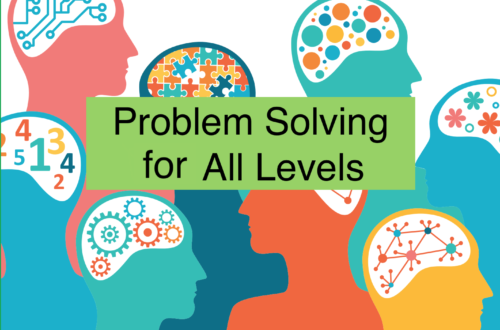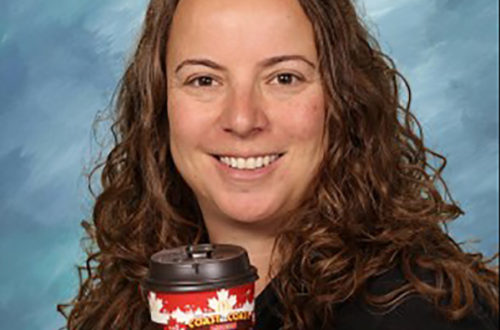Journal of the Mathematics Council of the Alberta Teachers’ Association
Volume 53 Issue 2, June 2015
My Thanks to You
Over the past 11 years, I have had the pleasure of editing delta-K. This has provided me with many opportunities, the most significant of which has been to work alongside passionate mathematics educators on the executive of the Mathematics Council of the Alberta Teachers’ Association. In particular, the leadership provided by members of MCATA has shaped my professional learning and. consequently, the content of this journal. I’m pleased to know many as colleagues and friends. This has been both a professional and personal journey.
I’ve had a great opportunity to meet and be mentored by those involved in the production of delta-K. The publication team at the Alberta Teachers’ Association has been tremendously helpful in providing editorial, artistic and creative advice. Contributors to delta-K have also encouraged me through supportive e-mails and postcards (yes, some sent news of vacations) that reminded me of the importance of relationships. Past editors of delta-K have shared their stories and experiences with me.
The first issue that I was involved with was coedited with Dr A Craig Loewen, dean of the Faculty of Education at the University of Lethbridge. He graciously mentored me in this process and offered much of his time to help me with the many questions I had. He was instrumental in providing direction and guidance as we transitioned to a peer-reviewed journal.
Other opportunities for working alongside a co-editor emerged. Lynn McGarvey initiated the idea for a special issue (2011, volume 48, number 2) focused on early childhood and mathematics education. The special issue of March 20 I 3 (volume 50, number 2) grew out of work with Egan Chernoff on the book celebrating 50 years of delta-K (see the description of the book included in this issue).
And finally, it is fitting that this issue (my last one) is coedited with Elaine Simmt. It represents all that is generative about mathematics education in our province. The collection of articles was written by mathematics teachers engaged in a graduate course. These articles show deep connections between theory and practice, a hallmark of delta-K since its inception. This collection demonstrates the importance of professional learning within a community. Elaine has provided an in-depth introduction in her editorial. I know that you will enjoy reading about how your colleagues are making sense of David Tail’s notion of three worlds of mathematics.
It is with mixed feelings that I make a transition out of being part of MCATA, but I’m very pleased that Lorelei Boschman has volunteered to become delta-K’s new editor. I got to know her when she became an instructor
for the mathematics curriculum and instruction course offered through the University of Alberta BEd program at Medicine Hat College. She has impressed me with her enthusiasm and commitment to mathematics education in Alberta. She has already shared ideas for forthcoming issues and will bring her own leadership gifts to the MCATA team. I’m proud to have been part of this legacy and know that delta-K is in great hands going forward.
Editing delta -K has been an experience where I have stood on the shoulders of giants. To those whom I have met throughout this journey, I thank you for the pleasure of your company.
Gladys Sterenberg
Gladys Sterenberg, PhD, was a classroom teacher in Lethbridge for I 5 years before pursuing graduate studies. As a faculty member at the universities of Lethbridge and Alberta, her passion for mathematics education was supported as she was mentored by professionals and academics in the field. Currently, she is an associate professor in the Department of Education at Mount Royal University. where she continues to work alongside teachers and teacher candidates in the province to enhance mathematics learning and teaching.
Reading, Writing and Arithmetic: Professional Development Through Communal Reading and Reflection as Mathematics Educators
Ongoing professional growth can be achieved in many ways. As a professor of mathematics education at the University of Alberta, I meet teachers who choose graduate studies as a means to grow as educators. In the winter of 2014, a group of PhD and MEd students participated in a course on mathematics learning systems. In that course the participants read about complex learning systems from a complexity science perspective. As a class we read Professor Emeritus David Tall’s new book, How Humans Lean to Think Mathematically: Exploring the Three Worlds of Mathematics, published in 2013 by Cambridge University Press, and discussed each chapter. The ideas in the book came alive as the teachers interpreted his ideas in the context of their own teaching practices. In this issue we present a number of the papers that teachers wrote to reflect on Tall ‘s work.
Tall is a British mathematics educator who studied under Richard Skemp (best known for his distinction between instrumental and relational understanding) and spent a lifetime working with learners of mathematics.
His book is an ambitious account of how mathematical thinking develops from infancy through adulthood and why mathematics in one context may be quite meaningful for a person, but when taken up in another context it lacks meaning or may interfere with the new way of thinking mathematically or the new mathematics to be learned.
At the core of Tall’s (2013) theory is a model of three worlds of mathematics with which humans interact: the embodied, the symbolic and the formal. This model suggests that a person’s development as a mathematical thinker requires perception and action across these three worlds. The embodied mathematical world is the starting place for all humans and all mathematics. Shape and space provide the grounding on which humans generalize and from which they can symbolize. Humans act on objects in the physical world with their bodies (hence through their bodily senses) and are acted on by the physical world in which they exist (through their bodily senses). Once symbols begin to replace objects, humans begin to act on the symbols. And like other objects that act on the learner (eg, a curved surface with no edges in contrast with a flat surface with multiple edges), symbols begin to act on the learner. Traces (physical and conceptual) are left when the learner interacts with the objects (concrete or symbolic [which becomes “concrete” for the learner]). The world of mathematics also includes the formal dimension. As the reader will learn, Tall points to both mathematicians’ notions of of formalism (set-theoretic definition and formal proofs) and psychologists’ (ie, Piaget’s) notion of formal operational
stage as aspects of formal mathematics.
A key concept developed by Tall (2013 ), the met-before really struck a chord with the teachers in the graduate course. Most simply stated, a met-before is a piece of mathematics or a result from some mathematics that
sticks with a student and affects subsequent encounters with mathematics. A met-before can be most helpful to a student learning something new or making a connection among mathematical concepts. Consider the connections between a square number (being the result of a number multiplied by itself) and a square root (the factor that was multiplied by itself to give the radicand). Also think about the connection between integer multiplication and division. Positive numbers multiplied together will result in a positive product, and two negative numbers multiplied together will result in a positive product. Hence, the middle school teacher takes
advantage of this met-before to help students understand that the radicand of a square root can be positive or negative. However, this met-before can become problematic when the high school teacher introduces the notion of the principal root. At that point, students need to let go of the generalization they have made of roots being positive or negative and now need to distinguish the principal root.
In this set of papers we see various interpretations of Tail’s (20 13) theory. In sum, the papers reflect many ways in which teachers not only read theory but how they interpret it for teaching practice. Powell, Asquith and Luo explore the met-before concept most directly in their papers and illustrate from their experience how met-befores affect the development of mathematics. Powell does so in the context of graphing functions on the graphing calculator, whereas Luo explores the power of using met-befores to develop algebraic forms of quadratic equations. Asquith uses the notions of both set-before and met-before to explore possibilities for teaching ELL students mathematics. Barton and Charles discuss Tail’s three worlds. Barton reflects on an experience she had doing a new piece of mathematics, from embodied pattern generating through symbolism and formalism. Through her reflection she unpacks Tall ‘s theory and in doing so unpacks her own understanding of the mathematics. Charles’s paper proposes a deliberate sequence of activities based on Tall’s three worlds to scaffold learners’ meaning making in trigonometry. Finally, Dias Correa offers Tail’s model as one of three different theories for observing student meaning making in mathematics.
I hope this focus issue of delta-K has introduced you as a mathematics teacher to some interesting theoretical perspectives on learning and on mathematics, and to some pragmatic suggestions for teaching mathematics. At the same time I hope you might consider initiating a reading group or book club in your school or among a group of neighbouring schools as a weekly or monthly professional development opportunity. Whether you initiate a reading group or do some personal professional reading, David Tail’s How Humans Leam to Think Mathematically might be a good selection for your next book.
Elaine Simmt
Elaine Simmt, PhD, is a former secondary school teacher of mathematics, chemistry and physics. For the past 17 years she has been a professor of secondary education at the University of Alberta. Her research is focused in mathematics education. In particular, she explores teaching and teaming as understood through the frame of complexity theory. A second and complementary area of study is centered in teacher education, specifically mathematics-for-teaching. In her most recent work, she has been doing international research and development projects in Tanzania to explore possibilities for mathematics teacher development in rural and remote communities. Simmt received the 2011 Friend of MCATA award from the Mathematics Council of the Alberta Teachers’ Association.
1
2 – 4
Gladys Sterenberg & Elaine Simmt
5 – 10
11 – 14
Solve the Following Equation: The Role of the Graphing Calculator in the Three Worlds of Mathematics
Jayne Powell
15 – 17
Repetition as a Means of Encouraging Tall’s Met-Befores in Mathematics
Lixin Luo
18 – 24
ELL Students’ Set-Befores and Met-Befores in Mathematics
Tom Asquith
25 – 30
Mathematical Thinking: An Argument for Not Defining Your Terms
Shelley Barton
31 – 36
Teaching the Trigonometric Ratios Through Embodiment, Symbolism and Formalism
Christopher Charles
37 – 43
Teaching Mathematics for Understanding: Approaching and Observing
Priscila Dias Correa
44 – 45
Book Announcement: Selected Writings from the Journal of the Mathematics Council of the Alberta Teachers’ Association: Celebrating
50 years (1962-2012) of delta-K
Edited by Egan J Chernoff & Gladys Sterenberg
46 – 47



